ASRock Brings Zen 2 NUC : 4X4 BOX-4800U Renoir Mini-PC Reviewed
by Ganesh T S on November 25, 2020 11:00 AM ESTSPECworkstation 3 Benchmark
The diminutive 4X4 BOX-4800U is not a workstation by any stretch of imagination. As an academic exercise, it is definitely interesting to look at how the system performs on a comparative basis across various professional applications. The SPECworkstation 3 benchmark measures workstation performance based on such applications. It includes more than 140 tests based on 30 different workloads that exercise the CPU, graphics, I/O and memory hierarchy. These workloads fall into different categories.
- Media and Entertainment (3D animation, rendering)
- Product Development (CAD/CAM/CAE)
- Life Sciences (medical, molecular)
- Financial Services
- Energy (oil and gas)
- General Operations
- GPU Compute
Individual scores are generated for each test and a composite score for each category is calculated based on a reference machine (HP Z240 tower workstation using an Intel E3-1240 v5 CPU, an AMD Radeon Pro WX3100 GPU, 16GB of DDR4-2133, and a SanDisk 512GB SSD). The SPEC Ratio for the tests in each category is presented in the graphs below.
Media and Entertainment
The Media and Entertainment category comprises of workloads from five distinct applications:
- The Blender workload measures system performance for content creation using the open-source Blender application. Tests include rendering of scenes of varying complexity using the OpenGL and ray-tracing renderers.
- The Handbrake workload uses the open-source Handbrake application to transcode a 4K H.264 file into a H.265 file at 4K and 2K resolutions using the CPU capabilities alone.
- The LuxRender workload benchmarks the LuxCore physically based renderer using LuxMark.
- The Maya workload uses the SPECviewperf 13 maya-05 viewset to replay traces generated using the Autodesk Maya 2017 application for 3D animation.
- The 3ds Max workload uses the SPECviewperf 13 3dsmax-06 viewset to replay traces generated by Autodesk's 3ds Max 2016 using the default Nitrous DX11 driver. The workload represents system usage for 3D modeling tasks.
| SPECworkstation 3.0.4 - Media and Entertainment Workloads | |||
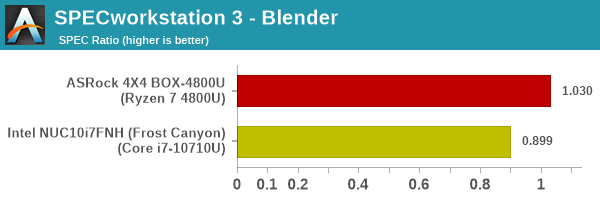
All the workloads can take advantage of the extra cores available in the Renoir APU (8 vs. 6 in the Comet Lake-U), and that helps the 4X4 BOX-4800U score handsomely over the Frost Canyon NUC.
Product Development
The Product Development category comprises of eight distinct workloads:
- The Rodinia (CFD) workload benchmarks a computational fluid dynamics (CFD) algorithm.
- The WPCcfd workload benchmarks another CFD algorithm involving combustion and turbulence modeling.
- The CalculiX workload uses the Calculix finite-element analysis program to model a jet engine turbine's internal temperature.
- The Catia workload uses the catia-05 viewset from SPECviewperf 13 to replay traces generated by Dassault Systemes' CATIA V6 R2012 3D CAD application.
- The Creo workload uses the creo-02 viewset from SPECviewperf 13 to replay traces generated by PTC's Creo, a 3D CAD application.
- The NX workload uses the snx-03 viewset from SPECviewperf 13 to replay traces generated by the Siemens PLM NX 8.0 CAD/CAM/CAE application.
- The Solidworks workload uses the sw-04 viewset from SPECviewperf 13 to replay traces generated by Dassault Systemes' SolidWorks 2013 SP1 CAD/CAE application.
- The Showcase workload uses the showcase-02 viewset from SPECviewperf 13 to replay traces from Autodesk’s Showcase 2013 3D visualization and presentation application
| SPECworkstation 3.0.4 - Product Development Workloads | |||

In GPU-intensive workloads, the Renoir APU marches well ahead of CML-U. In the couple of cases where the focus is on the CPU performance, the Renoir APU ekes out a slender lead.
Life Sciences
The Life Sciences category comprises of four distinct test sets:
- The LAMMPS set comprises of five tests simulating different molecular properties using the LAMMPS molecular dynamics simulator.
- The NAMD set comprises of three tests simulating different molecular interactions.
- The Rodinia (Life Sciences) set comprises of four tests - the Heartwall medical imaging algorithm, the Lavamd algorithm for calculation of particle potential and relocation in a 3D space due to mutual forces, the Hotspot algorithm to estimate processor temperature with thermal simulations, and the SRAD anisotropic diffusion algorithm for denoising.
- The Medical workload uses the medical-02 viewset from SPECviewperf 13 to determine system performance for the Tuvok rendering core in the ImageVis3D volume visualization program.
| SPECworkstation 3.0.4 - Life Sciences Workloads | |||
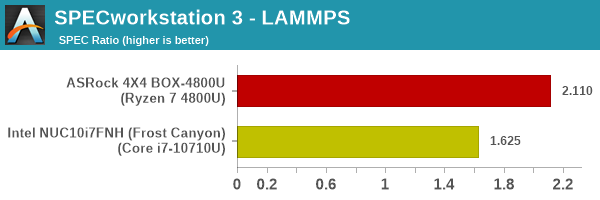
Similar to what was seen in the product development workloads, the Renoir APU marches well ahead of CML-U in the GPU-intensive tasks. In the couple of cases where the focus is on the CPU performance, the Renoir APU is still ahead.
Financial Services
The Financial Services workload set benchmarks the system for three popular algorithms used in the financial services industry - the Monte Carlo probability simulation for risk assessment and forecast modeling, the Black-Scholes pricing model, and the Binomial Options pricing model.
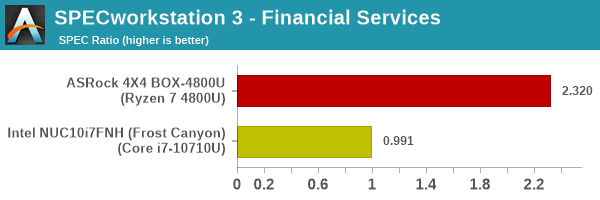
This workload is again able to take good avantage of available cores in the system, enabling the 4X4 BOX-4800U to provide more than double the performance of the Frost Canyon NUC.
Energy
The Energy category comprises of workloads simulating various algorithms used in the oil and gas industry:
- The FFTW workload computes discrete Fourier transforms of large matrices.
- The Convolution workload computes the convolution of a random 100x100 filter on a 400 megapixel image.
- The SRMP workload processes the Surface-Related Multiples Prediction algorithm used in seismic data processing.
- The Kirchhoff Migration workload processes an algorithm to calculate the back propogation of a seismic wavefield.
- The Poisson workload takes advantage of the OpenMP multi-processing framework to solve the Poisson's equation.
- The Energy workload uses the energy-02 viewset from SPECviewperf 13 to determine system performance for the open-source OPendTec seismic visualization application.
| SPECworkstation 3.0.4 - Energy Industry Workloads | |||
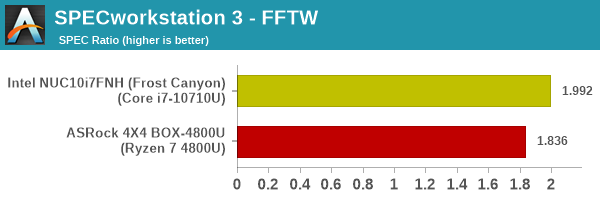
Most workloads are dependent on single-threaded performance here, with the 4X4 BOX-4800U trailing the Frost Canyon NUC in those cases.
General Operations
In the General Options category, the focus is on workloads from widely used applications in the workstation market:
- The 7zip workload represents compression and decompression operations using the open-source 7zip file archiver program.
- The Python workload benchmarks math operations using the numpy and scipy libraries along with other Python features.
- The Octave workload performs math operations using the Octave programming language used in scientific computing.
- The Storage workload evaluates the performance of the underlying storage device using transaction traces from multiple workstation applications.
| SPECworkstation 3.0.4 - General Operations | |||
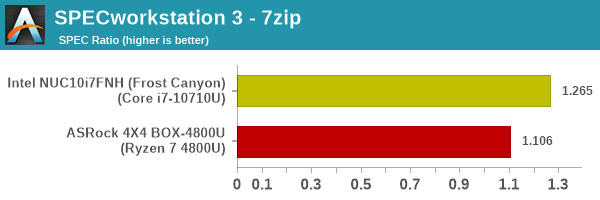
The match-up is a bit even for general operations, with the 4X4 BOX-4800U ahead in some, and the Frost Canyon NUC ahead in others (based on whether the workload is single-thread performance limited, or it is able to take advantage of a large number of cores)
GPU Compute
In the GPU Compute category, the focus is on workloads taking advantage of the GPU compute capabilities using either OpenCL or CUDA, as applicable:
- The LuxRender benchmark is the same as the one seen in the media and entertainment category.
- The Caffebenchmark measures the performance of the Caffe deep-learning framework.
- The Folding@Home benchmark measures the performance of the system for distributed computing workloads focused on tasks such as protein folding and drug design.
| SPECworkstation 3.0.4 - GPU Compute | |||
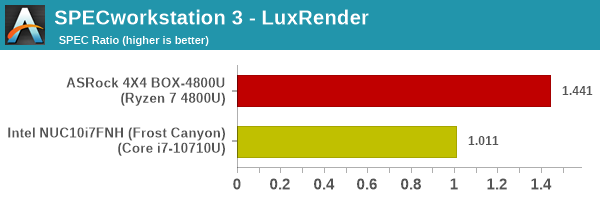
The 4X4 BOX-4800U managed to process all of the GPU compute benchmarks, but the Frost Canyon NUC couldn't process the Caffee and Folding @ Home tasks. As expected, the GPU compute performance of the AMD iGPU is better in the single workload where a comparison could be made.










53 Comments
View All Comments
redwingsbb - Saturday, November 28, 2020 - link
I don't think spikebike was saying that they would wait 2 years to buy I think they were saying it would be interesting to wait until CES in a couple of months to see whether there could be Zen 3 based NUC coming out in the next few months which in their opinion would be a big enough upgrade over a Ryzen 4000 based NUC to last them a full year or two longer.ifThenError - Monday, November 30, 2020 - link
You are very right, Zen3 in a small form factor would be a formidable plattform for many use cases. I'd happily swap my old box for such a device.Unfortunately I wouldn't expect this to happen anytime soon. Currently there is no such thing as a Zen3 based APU. The Zen2 based Renoir has just been released and still seems to have limited availability. It is more than a year behind the desktop and server Zen2 chips. Even if a Zen3 mobile chip was anounced in January, we would probably still be at least a year away from any SFF using it.
Looks like the devices from Asus and ASRock are your best bet, or you need a lot of patience.
Valantar - Thursday, November 26, 2020 - link
Pretty damn impressive seeing this hit above 1300 in Time Spy and nearly 14000 in night raid. My ITX 4650G with the iGPU@2100, RAM @3800c16 and IF@1900 hits >1600 TS and >17000 NR, but that also consumes ~100W from the wall. With this sitting in the 50s of watts except for initial spikes, that's very good performance for the tiny power draw.Really looking forward to how boxes like this evolve with DDR5.
Oh, and the dual NICs are brilliant. The 4350G version of this would make for a great PFSense box.
DanaGoyette - Thursday, November 26, 2020 - link
Realtek Virtual IPMI, on the Platform Analysis page....huh, does this have out-of-band management capabilities? If so, it could be useful as a server.
ganeshts - Thursday, November 26, 2020 - link
Yes, the 1G port has Realtek DASH enabled. I am actually investigating that feature right now (couldn't complete it in time for publishing the review), but information / guides are hard to come by. Realtek's own software that talks to DASH clients is a mess / very user unfriendly.watersb - Saturday, December 19, 2020 - link
And here (for reference) is the DASH overview article. Excellent!https://www.anandtech.com/show/16319/asrock-4x4-bo...
zakelwe - Friday, November 27, 2020 - link
Who cares about this? Where are the graphics card reviews from Amd and nVidia ?abufrejoval - Friday, November 27, 2020 - link
I had ordered the PN50 in summer with the Ryzen 4800U when a major EU retailer promised only 2-3 days deliver delays. Alas, the only thing that moved was the delivery delay, which increased and wound up as unknown. The Ryzen 4800U SoCs requires perfectly binned Renoir chips and those are likely to remain rare even while they are being replaced by 5800U chips (eve more attractive and harder to get?).I had to resort to team blue, which has some advantages in my KVM live-migration scenarios and could become especially interesting: if I can get Thunderbolt 40Gbit networking to work, I’d use that for the cluster/gluster interconnect and switch the USB 2.5Gbit NICs to the front-end. ASRock is doing the right thing here, I wish 2.5Gbit had long since become default everywhere, especially since I can’t believe Realtek charges more than a few cents extra for the speed uplift.
In the mean-time I’d just like to report that the NUC8i7BEH has had its price reduced to around €300 including EU VAT, while the BXNUC10I7FNH currently goes for €450. That comes down to €75/core and pretty much to core/€ parity with the 4800H at €600, which is why I got one of each in the end. Their combined idle power may actually not be higher than the AMD unit, while peak heat and noise are very well managed via OS independent BIOS settings on Intel NUCs these days.
The Bean Canyon’s Iris 655 iGPU main advantage is that it doesn’t cost one cent extra vs the ordinary i7-10700U UHD630, just as the 128MB eDRAM are given away for free and that L4 cache does at least deliver measurable performance advantages to the CPU, even if they aren’t noticeable. Both give an i7-7700K a run for its money on bursty desktop/server workloads, but less so as members of a render or compile farm.
While I’ll use both pretty much only for CentOS/oVirt, I did test them intensively on Windows with all sorts of graphics loads. AT basically infected me with curiosity about these larger Iris iGPUs years ago. 3DMark Night Raid at 1920x1080 IMHO shows their basic potential and why Apple used them as their main staple for a while, but the most impressive demo remains Google Maps with their AI created 3D view in Chrome (much slower in Firefox, unfortunately), which not only runs smoother on my 4k display, than Microsoft’s 2020 FlightSim on my RTX 2080ti/Ryzen 7 5800X game rig, but actually reflects what’s on the ground. FlightSim resorts to pure parametric random algorithms, which create ground structures and traffic patterns that not only carry no resemblance with ground truth, but don’t make sense, even at propeller speeds.
While I would probably still rationally prefer NUC innards as Mini-ITX boards for better options on cooling and general modularity, I’ve come to appreciate those NUCs mostly because the chassis and power supply come basically for free and at excellent build quality, while expansion on mobile SoCs is mostly external anyway.
Gadgety - Saturday, November 28, 2020 - link
Nothing on physical size or noise?Gadgety - Saturday, November 28, 2020 - link
110.0 x 117.5 x 47.85mm